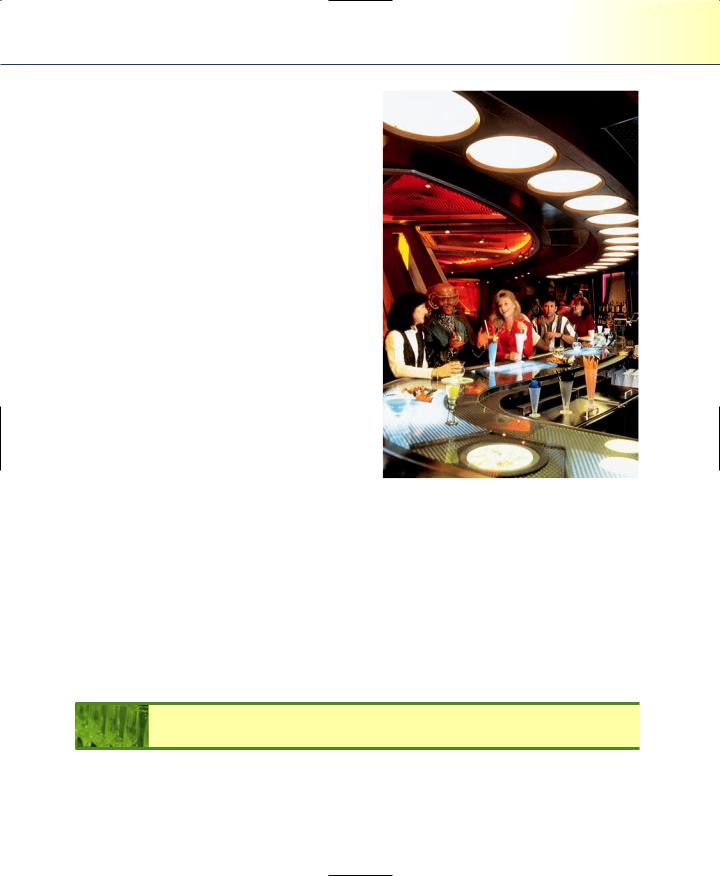
- •CONTENTS
- •PREFACE
- •Content—Benefits for Students
- •Content—Benefits for Instructors
- •Features of the Book for Students and Instructors
- •Supplementary Materials
- •Acknowledgments
- •What Is Hospitality Management?
- •The Manager’s Role in the Hospitality Industry
- •Why Study in a Hospitality Management Program?
- •Planning a Career
- •Employment as an Important Part of Your Education
- •Getting a Job
- •Employment at Graduation
- •The Outlook for Hospitality
- •Summary
- •Managing Change
- •Demand
- •Supply
- •Workforce Diversity
- •The Impact of Labor Scarcity
- •Summary
- •The Varied Field of Food Service
- •The Restaurant Business
- •The Dining Market and the Eating Market
- •Contemporary Popular-Priced Restaurants
- •Restaurants as Part of a Larger Business
- •Summary
- •Restaurant Operations
- •Making a Profit in Food Service Operations
- •Life in the Restaurant Business
- •Summary
- •Chain Restaurant Systems
- •Independent Restaurants
- •Franchised Restaurants
- •Summary
- •Competitive Conditions in Food Service
- •The Marketing Mix
- •Competition with Other Industries
- •Summary
- •Self-Operated Facilities
- •Managed-Services Companies
- •Business and Industry Food Service
- •College and University Food Service
- •Health Care Food Service
- •School and Community Food Service
- •Other Segments
- •Vending
- •Summary
- •Consumer Concerns
- •Food Service and the Environment
- •Technology
- •Summary
- •The Evolution of Lodging
- •Classifications of Hotel Properties
- •Types of Travelers
- •Anticipating Guest Needs in Providing Hospitality Service
- •Service, Service, Service
- •Summary
- •Major Functional Departments
- •The Rooms Side of the House
- •Hotel Food and Beverage Operations
- •Staff and Support Departments
- •Income and Expense Patterns and Control
- •Entry Ports and Careers
- •Summary
- •The Economics of the Hotel Business
- •Dimensions of the Hotel Investment Decision
- •Summary
- •The Conditions of Competition
- •The Marketing Mix in Lodging
- •Product in a Segmented Market
- •Price and Pricing Tactics
- •Place—and Places
- •Promotion: Marketing Communication
- •Summary
- •The Importance of Tourism
- •Travel Trends
- •The Economic Significance of Tourism
- •The United States as an International Tourist Attraction
- •Businesses Serving the Traveler
- •Noneconomic Effects of Tourism
- •Summary
- •Motives and Destinations
- •Mass-Market Tourism
- •Planned Play Environments
- •Casinos and Gaming
- •Urban Entertainment Centers
- •Temporary Attractions: Fairs and Festivals
- •Natural Environments
- •On a Lighter Note. . .
- •Summary
- •Management and Supervision
- •The Economizing Society
- •The Managerial Revolution
- •Management: A Dynamic Force in a Changing Industry
- •What Is Management?
- •Summary
- •Why Study Planning?
- •Planning in Organizations
- •Goal Setting
- •Planning in Operations
- •The Individual Worker as Planner
- •Long-Range Planning Tools
- •Summary
- •Authority: The Cement of Organizations
- •Departmentalization
- •Line and Staff
- •Issues in Organizing
- •Summary
- •Issues in Human-Resources Management
- •Fitting People to Jobs
- •Recruiting
- •Selection and Employment
- •Training
- •Retaining Employees
- •Staff Planning
- •Summary
- •The Importance of Control
- •Control and the “Cybernetic Loop”
- •Tools for Control
- •Summary
- •Leadership as Viewed by Social Scientists
- •Why People Follow
- •Leadership Theories
- •Communication
- •The Elements of Leading and Directing
- •Developing Your Own Leadership Style
- •Summary
- •A Study of Service
- •Rendering Personal Service
- •Managing the Service Transaction
- •How Companies Organize for Service
- •Summary
- •INDEX

Food Service and the Environment |
245 |
Restaurants have become much more sensitive to alcohol-related issues as evidenced by their responsible service programs. (Courtesy of Las Vegas Hilton and Paramount Pictures; Copyright 2001 Paramount Pictures. All rights reserved.)
response that has helped many operators is the development of a whole line of colorful and tasty “mocktails,” which are made without alcohol. Featuring “lite” beers and wines also caters to the guest’s desire to hold down caloric and alcohol intake and helps maintain sales. The biggest growth area has been in bottled water—bottled water not only replaces alcoholic beverages but is often drunk instead of other nonalcoholic beverages. There has been a tenfold increase in per capita consumption of bottled water since the 1970s, when bottled water was thought of as something to drink in a foreign country, and consumption has tripled just since 1985. In 2005, consumers drank an estimated 26 gallons per capita. Bottled water is actually beginning to rival beer and coffee in consumer consumption.12
Food Service and the Environment
Preserving the natural environment generates a great deal of concern and enthusi- asm—and rightly so. Our purpose here, however, is to narrow this view somewhat in looking at the impact of the environmental movement on food service. The view we

246Chapter 8 Issues Facing Food Service
will adopt, not surprisingly, is that of the business community, which looks at environmental proposals in terms of costs and benefits.
It can be difficult to discuss the environment because it is a sensitive issue for many and quickly becomes politicized. The concept can also be so broadly defined—for some, it includes water conservation, scaling back development, avoidance of animal testing by manufacturers of guest amenities, use of foods that have been naturally fertilized and have not been grown using pesticides, planting trees, and saving the rain forests. Problematically, such a broad and multifaceted notion of the environment makes it difficult to focus on the problems where food service can make a really strong contribution to the struggle to save the environment. We certainly cannot afford to be indifferent to the problems of the environment as it is more globally defined. In this chapter, however, we want to examine and understand problems that are a threat and need to be dealt with at the unit level.
Restaurants and food service in general are basically a clean industry rather than a polluting one, at least when compared with the heavy manufacturing industries. In some settings restaurants are faulted for creating traffic or noise problems. A few neighborhoods have objected to cooking odors coming from kitchen exhausts. These, however, are exceptional rather than everyday concerns. There are areas, however, in which food service faces, at the unit level, a serious environmental problem. Along with other businesses and every household in America, solid-waste disposal—otherwise called garbage—is a problem whose time has come. Garbage is not only an environmental problem but an operational problem as well. The cost of conventional waste disposal is rising and, because of the scarcity of landfills, is more than likely to continue to increase.
THINKING ABOUT GARBAGE FROM DUMP TO WASTE STREAM
Not very long ago, garbage was taken to the dump, and nobody thought much about the management issues involved. As the pressure of population, an ever richer economy, and a “throwaway society” interacted, however, problems of groundwater contamination, rodent infestation, toxic substances, and smell, to name a few, gave rise to a concern over the safety of what we now call a sanitary landfill. A first-class dump—that is, a sanitary landfill—costs something over $500,000 an acre to build. Specialized facilities designed to handle toxic substances, such as ash from incinerators, cost even more. To prevent groundwater contamination, a sanitary landfill is lined with clay or a synthetic liner and is equipped with a groundwater monitoring system. Because rotting garbage produces an explosive gas, landfills have methane collection systems. To keep down the smell as well as the insects and rodents, the day’s garbage is covered with a layer of dirt each night.

Food Service and the Environment |
247 |
Sanitary landfills are expensive to build and maintain. More important, it is now hard to find new dump sites, because communities really don’t want them in their own backyards. In fact, the number of landfill sites has dropped dramatically in recent years.
Americans generate over 4 pounds of garbage per person every day (from 50 to 100 percent more than other countries with similar standards of living). That is over 100 pounds a week for a family of four, over 3 tons per year. To put this in perspective, the United States generated 245 million tons of solid waste in 2005. The pressure not only from businesses but from households puts an increasing load on a declining number of landfills. The “tipping cost” (the cost to tip the contents of a garbage truck into a landfill) has doubled in a number of cities. The range is quite wide but fees are highest in the northeast ($90 per ton is not unusual). The management of solid waste is a $43 billion industry in the United States.
Just at the point where the demand for landfill space is rising and the supply of such space is declining, another complication arises—public attitudes. The American public views environmental issues as one of the key issues of the day. Environmentally concerned citizens are also food service customers, and their strong views need to be taken into account. In fact, opinion surveys show that environmentally concerned people make up about half the population—and they are both the highest in income and the best educated. Restaurants’ interest in the solid-waste problem, then, is driven by a concern to be responsible corporate citizens, by the concerns of their best customers, and by exploding waste-removal costs. As a result, we have replaced the concept of the dump, where things are dropped and forgotten, with that of a waste stream, which needs to be managed.
MANAGING THE WASTE STREAM
A study conducted at the University of Wisconsin—Stout gives us a good idea of the composition of the food service waste stream. On-site food service and table service restaurants generate about 1 pound of waste per meal served, whereas quick-service establishments generate roughly 11⁄3 pounds per meal.13 Table 8.2 shows the types and proportions of waste generated by the major categories of food service.14
As we set out to consider how the waste stream is to be managed, a word of caution is in order. The public perception of environmentally effective action is not necessarily consistent from year to year. In some cases, popular environmental views don’t always make physical sense. McDonald’s switched hamburger wrappings in 1976 (from paper to polystyrene) and received positive press for its perceived interest in saving trees. When McDonald’s switched back to paper 15 years later, it was again hailed as an environmental victory. Both public perception and scientific fact (as well as timing) need to be taken into consideration when making such decisions. Figure 8.1

248 |
Chapter 8 Issues Facing Food Service |

 TABLE 8.2
TABLE 8.2


























































Contents of the Food Service Waste Stream by Food Service Type
PROPORTION OF WASTE STREAM
TYPE OF WASTE |
INSTITUTIONAL |
TABLE SERVICE |
QUICK SERVICE |
Paper |
40% |
44% |
65% |
Plastic |
23 |
16 |
17 |
Food |
23 |
21 |
5 |
Glass |
5 |
12 |
4 |
Tin |
8 |
3 |
6 |
Aluminum |
1 |
4 |
3 |
Source: Data adapted from Peter A. D’Souza and Leland L. Nicholls, “Waste Management: The Priority for the 1990’s,” Technical Paper, University of Wisconsin—Stout, n.d.
reflects some of the changes that the McDonald’s corporation has made in an effort to reduce its waste stream.
The techniques available to deal with the waste stream can be summarized in three words: reduce, reuse, and recycle. These are the ideal solutions, but the facts of life require our list to be expanded to include composting, incineration, and the use of landfills.
1990: Reduced thickness of sundae cups 1991: Reduced size of napkins by one inch
1992: Reduced basis weight of Happy Meal bag 1993: Reduced back flap of fry carton
1994: Reduced thickness of trash can liners 1995: Replaced hash brown cartons with bags 1996: Changed to thinner carry-out bags 1997: Decreased weight of in-store trays
1998: Converted to sandwich wraps for fish sandwich
1999: Introduced insulated wraps for Quarter Pounder sandwich
2002—2004: Continue to decrease the weight of paper napkins and cardboard packaging and to use a higher percentage of recycled materials in napkins.
Figure 8.1
Changes made to McDonald’s packaging materials, 1990–2004 (Source: mcdonalds.com with permission from McDonald’s Corporation.)

Food Service and the Environment |
249 |
Reduce. Increasingly, the public is glad to be offered the possibility of receiving a product without wrapping or a bag, and some quick-service companies are offering customers sandwiches without their customary paper wrapping. Often, it is possible to switch to a less bulky form of packaging—from cardboard to paper, for instance. Companies are also insisting that suppliers provide product in packaging that minimizes waste.
McDonald’s switch back to paper reduced the volume of packaging waste by 90 percent. We need to note, however, that the plastic-laminated paper it now uses is likely to decay only very, very slowly, if at all, in a landfill.
Thus, although a reduction in bulk was realized by McDonald’s decision, it is questionable whether the overall environmental impact has been positive or not. They have made numerous other changes, however, and the combination has undoubtedly had a significant impact.
Reuse. Another seemingly appealing strategy for many operations is a switch from disposables to permanent ware (reusable china or plastic dinnerware). This would reduce dramatically paper and plastic waste. The problems this “solution” creates, however, suggest once again how important it is not to oversimplify. Restaurants built to rely on disposables have no space to locate a dish room or china storage. If they remodeled to put it in, the cost would be exorbitant, and space would probably have to come from customer seating—with reduced sales as the result. A heavy expenditure resulting in reduced sales would bankrupt many restaurants. Even if we assume, implausibly, that such a development could take place, the result of all the additional water discharged would cause the city sewage system, quite literally, to explode. A dishwasher, after all, requires from 70 to 500 gallons of water per hour to operate. Such an increase in dishwashing would also result in thermal pollution of rivers from the hot water and chemical pollution from the very strong soaps used in dishwashing.
Other forms of reuse are more practical. Products can be bought in containers that can be returned to the manufacturers for reuse or reused in the operation.
Instead of discarding skids in a warehouse or commissary, most are now being built to stand up to reuse.
The major opportunities available from a strategy of reducing and reusing appear to lie with changes in the way products are purchased. Minimizing unnecessary packaging, eliminating the use of toxic dyes or other substances that make packaging hard to recycle, and using recycled products or recycling containers all contribute to a reduction in the total waste stream. One enterprising restaurant owner purchases extra flatware at garage sales to “loan” to customers when they purchase takeout meals from his restaurant. He only asks that they return it to the restaurant after using it. He finds that the cost is minimal and outweighs the cost of buying and supplying disposable flatware.

250Chapter 8 Issues Facing Food Service
Recycle. A substantial amount of recycling is already going on across food service segments. Metal, paper, cardboard, and glass are already established as recyclables. We should note, however, that, in recycling, all metals are not equal. Steel cans can be and are usefully recycled, but the advantages are nowhere near as great as they are for aluminum cans. In fact, it’s now cheaper to recycle aluminum than it is to mine bauxite, the ore from which aluminum is extracted.
The key factor in recycling is its economics. True, the materials in the waste stream have some value, but the basic driving force is the rise in landfill costs. Although some communities still have adequate landfill space, the evidence suggests that waste trucked in from distant cities will, in time, fill these. Overall, landfill costs, as we noted earlier, are rising, and for large metropolitan areas, landfill availability is disappearing.
Recycling, however, requires considerable effort. Think about the case of quickservice food waste. If we want to recycle, it will be necessary to sort the waste into recyclable categories. Some operators, particularly institutions, are using consumer sorting. Consumers may be asked to use different bins for glass, paper, plastic, and food waste. Let us assume that we decide to persuade our customers to sort paper, plastic, and food waste into separate containers. New bins—taking up additional floor space—must be installed and a suitable “training program” set up for our guests. This educational effort would almost certainly include special signage showing the guest what was expected, and tray liners and posters explaining why we’re undertaking this effort. At least during the start-up period, some personal assistance to explain the process—and solicit people’s support—would probably be required. The trash will then very likely have to be re-sorted either by an employee, by the waste hauler, or by the recycler. Thus, sorting itself requires considerable time and effort. Plastics, moreover, will need to be further sorted according to resin type, using the codes shown in Figure 8.2.
The storage we presently have is probably a dumpster, with perhaps a second container for corrugated boxes. Under the new regimen, however, we will need separate containers for several categories of waste. They certainly won’t fit into the present back of the house, so they will almost certainly have to be crowded into the loading dock area, which may require some redesign to make everything fit and still have room for delivery trucks.
This is not the end of the complications. We probably at present have only one hauler, a company that does everything for us with one type of truck. Under the new arrangements, different haulers might be required: one for paper, another for metal, and so forth. Even assuming one company does all of the work, the truck that does the hauling will have to have multiple compartments, or possibly the hauler will have to use more than one truck, each designed for different parts of the waste stream.

Food Service and the Environment |
251 |
1 |
2 |
3 |
PETE |
HDPE |
V |
Polyethylene |
High-Density |
Vinyl or |
Terephthalate |
Polyethylene |
Polyvinyl |
|
|
Chloride |
4 |
5 |
6 |
7 |
LDPE |
PP |
PS |
OTHER |
Low-Density |
Polypropylene |
Polystyrene |
All Other Resins |
Polyethylene |
|
|
and Multiple and |
|
|
|
Blend Resins |
Figure 8.2
Society of the Plastics Industry (SPI) coding system. (Source: plasticindustry.org, 2004.)
Because the technology of sorting garbage is changing rapidly, it may be that much more of the sorting will be done at recycling centers in future years. This could significantly reduce the restaurant’s labor cost in sorting and make recycling more attractive.
As we have noted, the advantage to the restaurant of recycling is financial—the hauling fees for recycling are less than the tipping fees at the landfill. A further major advantage is that of public relations. Customers are concerned about the environment and are likely to react favorably to firms that are leaders or solid performers in the environmental arena.
Compost. Composting refers to the collection and processing of food trimmings, scraps, and leftovers. Small-scale composting has been going on in rural areas (and backyards) for centuries. However, as a large-scale movement affecting all of society, it is still in its infancy.
Because of the wet, dense nature of food waste, it must be combined for composting with a bulking agent such as leaves, wood chips, or shredded paper to allow for air circulation. The material is placed in rows and, in most present-day applications, a front-end loader is used to turn the material periodically to maintain exposure to the air. More mechanized plants to manage the composting process will undoubtedly become common in the future. Finished compost can be used as potting soil or to enrich a garden or the soil around trees or bushes. Test programs have been successful in a number of municipalities, some of which report a reduction in garbage removal costs of 50 percent.

252Chapter 8 Issues Facing Food Service
Incinerate. Incineration (or combustion) provides yet another way to dispose of waste. Currently, 15 percent of all waste nationwide is disposed of in this manner. Some states, such as Florida and Maine, incinerate over 20 percent of their waste.15 Unfortunately, combustion of waste creates environmental problems of its own and, as a result, is subject to a great deal of controversy. One principal concern is air pollution; however, it does appear that technical advances in scrubber systems and combustion control make it possible to overcome these problems in properly managed systems. As no management system is perfect, what this means is that, in practice, air pollution control may not be perfect. Because the air pollutants can include heavy metals, acid that leads to acid rain, and poisonous dioxin, this is no small issue.
A second problem is that 25 percent of the product remains as ash after combustion and must be placed in a landfill. Looked at another way, this means that combustion reduces waste by 75 percent (by weight). However, because the remaining ash contains toxic pollutants, the danger of eventual leaching into groundwater is a serious one. Specialized landfill sites with extra protection against leaching are needed.
A further concern put forward by environmentalists is the contribution that incineration can make to the greenhouse effect. Where the only alternative to incineration is dumping in a landfill, this concern is misplaced. Landfills generate methane, which traps heat radiation and, hence, contributes more to the greenhouse effect than would the gases given off by incineration. If, however, the alternative to incineration is recycling, recycling would be preferred both because of its environmental impact (air quality and elimination of ash) and because of its significantly lower cost to the community and to individual businesses.
Landfill. The least preferred, but most commonly used, method of disposal is the landfill. Fifty-seven percent of solid waste ends up in such sites.16 They are costly to construct and maintain and are potentially long-term environmental hazards. They hide rather than dispose of the trash, which decays only very slowly and imperfectly under the landfill’s conditions of lack of oxygen and moisture. As noted, they can contribute to a worsening of the greenhouse effect. It appears that the scarcity of landfills may eventually drive the cost of this method of disposal beyond what most operations can afford.
Fortunately for food service operators, residential recycling programs being set up by municipalities and other governmental agencies may eventually create the channels of collection, redistribution, and processing necessary to make large-scale recycling work. As our discussion makes clear, moving toward recycling is no simple matter, but at the same time, the amount of waste that is being recycled doubled over a 15-year period.17 Managing the waste stream will almost certainly be a concern that touches your career, so it is good to have a broad understanding of it.
